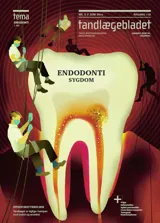Cone Beam Computer-tomografi til diagnostik af periapikale læsioner
Formålet med denne undersøgelse var at vurdere brugen af Cone Beam Computer-tomografi (CBCT) til diagnostik af periapikale læsioner. En søgning i MEDLINE (PubMed) blev foretaget for at identificere studier, publiceret i perioden januar 2000 – juli 2013, der vurderede brugen af CBCT til diagnostik af periapikale læsioner. En kombination af følgende søgeord blev anvendt: (apical pathology OR endodontic pathology OR periapical OR lesion OR healing) AND (CBCT OR cone beam CT). Søgningen var begrænset til engelsksprogede artikler. Studierne blev registreret og kategoriseret på en 6-trinsskala. I alt 25 studier blev inkluderet. Af de inkluderede artikler var 20 humane studier (14 in vivo, seks ex vivo), mens fem var dyrestudier (fire in vivo, et ex vivo). I 12 studier blev der anvendt en såkaldt Gold Standard til verificering af diagnosen. Af disse 12 anvendte fire histologisk undersøgelse som Gold Standard. Ud fra den tilgængelige litteratur kan det konkluderes, at der diagnosticeres flere periapikale læsioner med CBCT end med konventionelle røntgenmetoder. Samtidig ses en tendens til øget diagnostisk rigtighed ved brugen af CBCT til diagnostik af periapikale læsioner. Den tilgængelige information er endnu ikke tilstrækkelig til, at man kan anbefale brugen af CBCT som standardmetode til diagnostik af periapikale læsioner. Endvidere savnes undersøgelser, der viser, at anvendelsen af CBCT har betydning for, hvilken behandling en patient modtager, og om patienten i sidste ende har gavn af en CBCT-undersøgelse.
Cone Beam Computed-Tomography for the diagnosis of periapical lesions: The objective of this study was to perform a systematic review on the use of cone-beam CT (CBCT) for the diagnosis of periapical lesions. The MEDLINE bibliographic database was searched from 2000 to July 2013 for studies evaluating the use of CBCT images for diagnosing periapical lesions. The search strategy was limited to English-language publications using the following combined terms: (apical pathology OR endodontic pathology OR periapical OR lesion OR healing) AND (CBCT OR cone beam CT). The studies were recorded and categorized according to a 6-level scale. The review identified 25 publications that fulfilled the inclusion criteria. Of the included studies were 20 human studies (14 in vivo, 6 ex vivo), and 5 were animal studies (4 in vivo, 1 ex vivo). Twelve studies used a Gold Standard for verification of the correct diagnosis, and among these 4 studies used histology as the Gold Standard. From the available literature it can be concluded that there is a tendency to diagnose more periapical lesions in CBCT than in periapical images. Furthermore, there is a tendency towards a higher diagnostic accuracy when using CBCT in the detection of periapical lesions. However, on the basis of existing studies CBCT cannot be justified as a standard method for the diagnosis of periapical lesions, and studies demonstrating the benefit of CBCT for the patient are still lacking.


